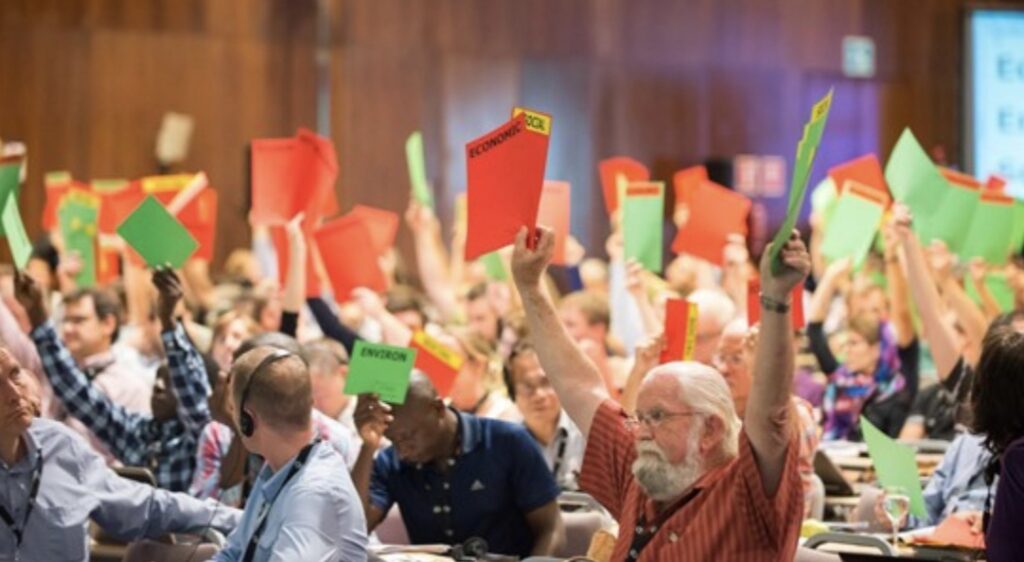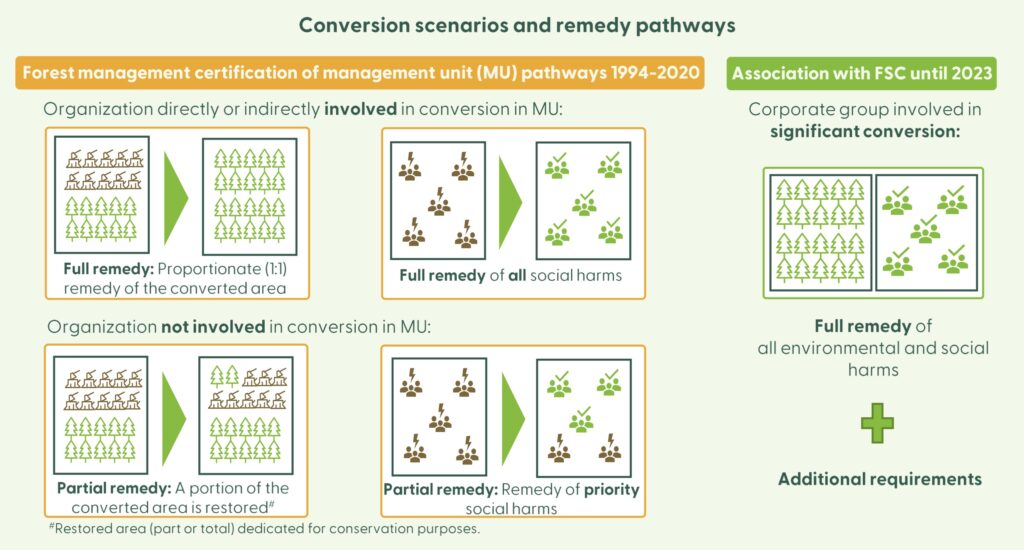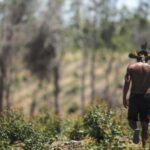The Forest Stewardship Council (FSC) is widely recognized for setting the bar on sustainable forest management with its voluntary certification standard. For forest investors, when an asset they invest into has FSC forest management certification, it gives great confidence that the forest is being managed for all of economic, environmental, social and governance issues, giving due respect for the multitude of values generated from the forest and those that depend on them. It is often the preferred Standard for investors in emerging geographies with poor forest governance, specifically for its robustness.
All that said, the debate over the “conversion” issue is giving investors cause for pause, as some fear the requirements associated with conversion are becoming too impractical. In this latest article, I’m going to give you the rundown on what you need to know about the finally approved FSC Conversion policy and associated remedy requirements, and let you know how – as an investor, you can make this requirement work for your investments – in strategy, policy and practice.

FSC’s General Assembly in 2017 – the General Assembly is the highest FSC platform for decision making
The FSC Conversion Policy
First things First – What is Conversion?
Conversion, or specifically conversion of natural forest cover, is defined in FSC’s Policy of Association – the ultimate eligibility list, as one of several unacceptable activities:
FSC’s Unacceptable Activities:
- Illegal harvesting or illegal trade in forest products
- Violation of customary or human rights within the forestry or forest products sector
- Violation of workers’ rights and principles defined by ILO
- Destruction of High Conservation Values (HCVs) in forests or HCV areas
- Conversion of natural forest cover
- Use of genetically modified organisms in forestry operations
FSC defines Conversion of natural forest cover as
A lasting change of natural forest cover induced by human activity. This covers gradual forest degradation as well as rapid forest transformation.
- Induced by human activity: In contrast to drastic changes caused by natural calamities like hurricanes or volcanic eruptions. It also applies in cases of naturally ignited fires where human activities (e.g., draining of peatlands) have significantly increased the risk of fire.
- Lasting change of natural forest cover: Permanent or long-term change of natural forest cover. Temporary changes of forest cover or structure (e.g., harvesting followed by regeneration in accordance with the FSC normative framework) is not considered conversion of natural forest cover.
The 1994 Cut-Off Rule
FSC’s position on conversion has been evolving with much debate over the 1994 cut-off rule, whereby forests that have been converted after 1994 were ineligible for certification. The topic has been front of mind for FSC stakeholders, as there are so many nuanced situations in which the rigidity of this black and white rule did not fit the local context – making otherwise sustainable forest management practices ineligible for certification.
Investors and Investment Managers have leaned on this rule, as they screen projects for their investment strategies, finding that in many cases – excellent opportunities needed to be excluded because conversion may have taken place since that time period, making the asset ineligible for FSC certification. This is especially common in tropical developing geographies, where for example, incremental degradation was taking place slowly over time due to unsustainable farming practices. Another example includes where converted forest was acquired by a new party, legitimately improving forest management in accordance with FSC standards – but the new party has been unable to qualify, as the forest was converted after the 1994 cut-off date.
FSC’s Current Position on Conversion
Though the current form of FSC’s conversion policy was approved in January 2023, the organization has now started its campaign to educate on their Policy to Address Conversion and the associated FSC Remedy Framework (the Remedy Framework comes into effect in July 2023). There is a plethora of related resources, if you want to dig into fully understanding this topic:
FSC Remedy Framework Executive Summary | FSC Connect: Very brief overview on the main rules around certification, association, conversion and remedy.
Factsheet: Conversion and remedy (fsc.org): A useful and comprehensive summary of the FSC Conversion and Remedy policy landscape.
Development of FSC -POL-01-007 Policy to Address Conversion | FSC Connect: A timeline showing the detailed policy developments around conversion.
FSC Remedy Framework | FSC Connect: Defines how certification is possible under certain conditions where conversion has taken place, so long as organizations remedy past social and environmental harm.
Policy for Association | FSC Connect: Defines unacceptable destructive activities that make organizations ineligible for forest certification (or association), of which, conversion of natural forest is one.
What once was the black and white 1994 cut-off date, can now be interpreted through the following scenarios.
| Scenario Description | Certification and Remedy Considerations |
| Natural forest converted prior to 1 December 1994 | – No remedy required for certification and association |
| Natural forest converted between 1 December 1994 and 31 December 2020 | – Remedy required for certification (FSC-PRO-01-007) – Remedy required for association (FSC-PRO-01-007) if conversion meets significant conversion threshold defined in the FSC Policy for Association (V2) |
| Natural forest and High Conservation Value (HCV) areas converted after 31 December 2020 | – Certification is not possible – For Association -Between 1 January 2021 and 31 December 2022 (Remedy required as above for significant conversion) -After 31 December 2022, Remedy required according to FSC-PRO-01-004 (Policy for Association V3) |
In Short:
- Conversion prior to 1994: Certification is possible, with no remedy
- Conversion between 1994-2020: Certification is possible, with remedy requirements
- Conversion after 2020: Certification is not possible.
What does Remedy Entail?
What happens in that fuzzy period between conversion that has taken place between 1994 and 2020? FSC has created this helpful illustration to understand the remedy requirements.

There is no one-size-fits-all remedy prescription, though FSC has outlined the following key concepts. More details can be found in the FSC Remedy Framework.
- Identification of relevant stakeholders and differentiation between rights holders and other stakeholders,
- Application of Free, Prior, Informed Consent (FPIC) for affected rights holders,
- Dialogue processes,
- Agreements at key points,
- Best practice justifications of selected remedy actions,
- Independent / expert involvement,
- Actual sites prioritized,
- For conversion remedy 20% reserved as protected area
Pragmatic Application of the No-Conversion Principle
How do you, as a forest investor or investment manager apply the new FSC conversion and remedy requirements practically into your investment policies and procedures, and pass these on to your investees? To answer this – let’s break it down to the various stages in your investment journey.
- Investment Strategy
If Additionality is important to your investment strategy (this article gives a good definition of additionality in the context of forest investment), it is likely you will be looking to integrate assets that are not yet certified and have them achieve forest management certification (where FSC is an obvious well-recognized option). Consider at this stage what limitations this might bring for you in terms of your pipeline opportunities, and how you can diversify (perhaps allowing for different certification schemes in geographies where these are well developed, and which are less restrictive).
- Policy
Once you have your strategy defined, you will need to get working your investment documentation. Forest certification will slide into your ESG or sustainability policies and procedures. Related to conversion, you will need to develop your policies in-line with FSC’s Policy for Association, Conversion and Remedy. The Policy will include the headline criteria, such as No conversion of natural forest cover. The rules of how this is described will then be transcribed into your procedures, for how you and your investees ensure natural forests are not converted.
- Screening and DD Criteria – assets and managers
If FSC certification is a requirement of your strategy, you will need to carefully screen deals to understand if conversion has taken place. This will likely involve remote sensing analysis and an interview process with local stakeholders to understand if/when conversion has taken place. If the asset falls into the grey area of conversion between 1994-2020, you will need to undergo a cost-benefit analysis, to understand the financial and management risks of committing to any remedy.
- Conditional acceptance – pursue, budgetary requirements, consultations
In asset negotiations, you will integrate your remedy requirements. You will specify additional work that is required to confirm converted areas (if this is a risk). If you are confident there has been conversion and you want to proceed, you will need to communicate to your asset operator that they will need to follow FSC’s remedy requirements.
- Ongoing Management
After you have acquired the asset, where it is assumed there is a portion of the area that has been converted, you will commence the remedy process. Here it is important that asset operators fully understand the Remedy Framework, and build it into their operational procedures, including stakeholder engagement. Remedies will be designed in close connection with affected stakeholders and budgets will need to include sufficient funding to execute the remedy. As an investment manager, it will be important to keep tabs on this process, which will be running in connection with the full FSC certification process.
Get Help Integrating Certification Requirements into your Forest Investment Strategy
If you are interested in building a strong forest investment strategy that integrates forest management certification and a supporting ESG framework to help you execute it, my ESG integration approach might be right for you. I offer the following services:
- ESG Integration Strategy Roadmap – If you are in the early stages of designing a new investment strategy, with this roadmap you will get an actionable plan to integrate risk-reducing, benefit-creating and value-generating ESG into your strategy.
- ESG Integration Workshops – If you are making the transition from a conventional forest or land-based investment strategy to one that integrates ESG objectives, or you are new to forest and land-based investments, these workshops will help your team get up to speed on the opportunities, and address concerns with ESG integration, and get your whole team co-creating an ESG-integrated investment strategy you will all stand behind.
- Customized ESG Management Framework Development – If you are ready to build the bridge between an ESG integrated strategy and implementation, but lack the resources to build the systems yourself, I can support to build your ESG Framework customized to your strategy.
- ESG Integration Advisory – If you have the horsepower to build up your integrated ESG strategy and management framework in house, but would like advisory support to discuss ideas, solutions, and opportunities – this customized service will help you efficiently and confidently move your strategy into action.
This approach is also applied to forest and land-based companies, looking for a straightforward approach to meet investors’ ESG requirements.
Please reach out if you are an investor, investment manager or forest/land-based company interested to see how my integrated ESG approach could best serve your needs.
Did you like this article? Sign up now for the ForestLink’s newsletter, where you’ll receive technical advice, reflections, and best-practice guidance to support you with your forest-linked investment strategy or business straight to your inbox.





